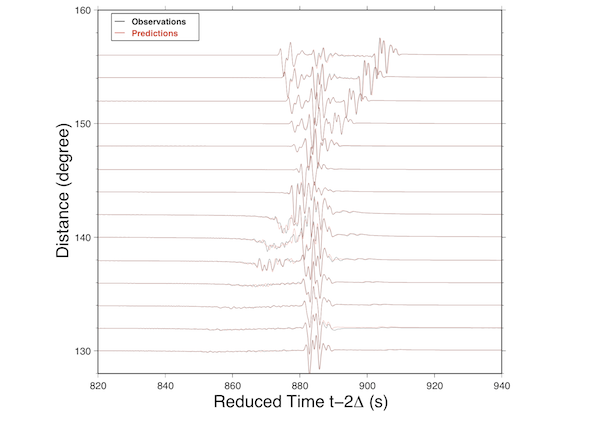2012 IRIS Workshop
Velocity and Attenuation Structure of the Earth's Inner Core Boundary Based on an Automatic Waveform Modeling Method
Jing Jin: University of Illinois at Urbana-Champaign, Xiaodong Song: University of Illinois at Urbana-Champaign
The observations (black) and predictions (red) in the synthetic test. The observations are produced by generalized ray theory using the reference Earth model PREM2. The predictions are calculated using the final model found by the neighborhood algorithm. The waveforms of observations and predictions are similar, which indicates the automatic waveform modeling method is useful in studying the structure of the inner core boundary.

Full-resolution graphics file in original format: 0018.ps
A one-dimensional P wave velocity and attenuation structures of the lowermost 200 km of the outer core and the uppermost 500 km of the inner core is developed by a new automatic waveform modeling method. The data consist of both short period and long period seismic record sections gathered from different seismic arrays. The neighborhood algorithm is used to search for the best velocity and attenuation models from a continuous high-dimensional model space. The predicted waveforms of PKP(df) and PKP(bc) phases generated by generalized ray theory are directly compared with the observations. The differential traveltimes between these two core phases are mainly affected by the P wave velocity structure near the inner core boundary (ICB), whereas the amplitude ratios are more likely to be affected by the attenuation structure of the uppermost inner core. The P wave velocity model derived by this new method shows its consistency with previous Earth models such as the Preliminary Reference Earth Model (PREM). The radial structure obtained can be used as a reference model to develop a three-dimensional structure near the ICB, and the automatic waveform modeling method may also be applied to study the Earth’s structure at different depths.
Keywords: inner_core_boundary, automatic_waveform_modeling
